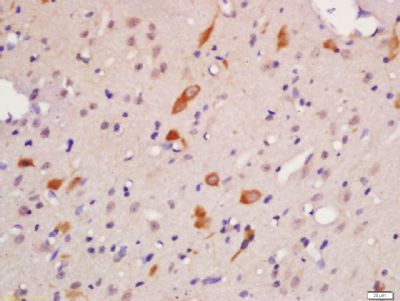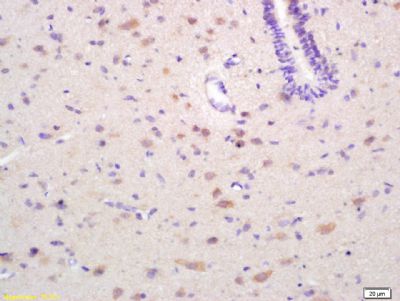产品中心
当前位置:首页>产品中心Anti-EPH receptor A4
货号: bs-1764R 基本售价: 1380.0 元 规格: 100ul
- 规格:100ul
- 价格:1380.00元
- 规格:200ul
- 价格:2200.00元
产品信息
- 产品编号
- bs-1764R
- 英文名称
- EPH receptor A4
- 中文名称
- 酪氨酸蛋白激酶受体A4抗体
- 别 名
- Cek 8; CEK8; EK8; Eph A4; EPH receptor A4; EPH-like kinase 8; EphA4; EPHA4_HUMAN; Ephrin receptor Eph A4; Ephrin receptor EphA4; Ephrin type A receptor 4; Ephrin type-A receptor 4; HEK 8; HEK8; hEK8; Receptor protein tyrosine kinase HEK 8; Receptor protein tyrosine kinase HEK8; Receptor protein-tyrosine kinase HEK8; Sek 1; SEK; TYRO 1; TYRO 1 protein tyrosine kinase; TYRO1; Tyrosine protein kinase receptor SEK; Tyrosine protein kinase TYRO1; Tyrosine-protein kinase receptor SEK; Tyrosine-protein kinase TYRO1.
- 规格价格
- 100ul/1380元购买 200ul/2200元购买 大包装/询价
- 说 明 书
- 100ul 200ul
- 研究领域
- 肿瘤 免疫学 激酶和磷酸酶
- 抗体来源
- Rabbit
- 克隆类型
- Polyclonal
- 交叉反应
- Human, Mouse, Rat, Chicken, Dog, Pig, Horse, Rabbit,
- 产品应用
- ELISA=1:500-1000 IHC-P=1:400-800 IHC-F=1:400-800 IF=1:100-500 (石蜡切片需做抗原修复)
not yet tested in other applications.
optimal dilutions/concentrations should be determined by the end user.
- 分 子 量
- 106kDa
- 细胞定位
- 细胞浆 细胞膜
- 性 状
- Lyophilized or Liquid
- 浓 度
- 1mg/ml
- 免 疫 原
- KLH conjugated synthetic peptide derived from human EphA4:531-630/986 <Cytoplasmic>
- 亚 型
- IgG
- 纯化方法
- affinity purified by Protein A
- 储 存 液
- 0.01M TBS(pH7.4) with 1% BSA, 0.03% Proclin300 and 50% Glycerol.
- 保存条件
- Store at -20 °C for one year. Avoid repeated freeze/thaw cycles. The lyophilized antibody is stable at room temperature for at least one month and for greater than a year when kept at -20°C. When reconstituted in sterile pH 7.4 0.01M PBS or diluent of antibody the antibody is stable for at least two weeks at 2-4 °C.
- PubMed
- PubMed
- 产品介绍
- background:
This gene belongs to the ephrin receptor subfamily of the protein-tyrosine kinase family. EPH and EPH-related receptors have been implicated in mediating developmental events, particularly in the nervous system. Receptors in the EPH subfamily typically have a single kinase domain and an extracellular region containing a Cys-rich domain and 2 fibronectin type III repeats. The ephrin receptors are divided into 2 groups based on the similarity of their extracellular domain sequences and their affinities for binding ephrin-A and ephrin-B ligands.
Function:
Receptor tyrosine kinase which binds membrane-bound ephrin family ligands residing on adjacent cells, leading to contact-dependent bidirectional signaling into neighboring cells. The signaling pathway downstream of the receptor is referred to as forward signaling while the signaling pathway downstream of the ephrin ligand is referred to as reverse signaling. Highly promiscuous, it has the unique property among Eph receptors to bind and to be physiologically activated by both GPI-anchored ephrin-A and transmembrane ephrin-B ligands including EFNA1 and EFNB3. Upon activation by ephrin ligands, modulates cell morphology and integrin-dependent cell adhesion through regulation of the Rac, Rap and Rho GTPases activity. Plays an important role in the development of the nervous system controlling different steps of axonal guidance including the establishment of the corticospinal projections. May also control the segregation of motor and sensory axons during neuromuscular circuit development. Beside its role in axonal guidance plays a role in synaptic plasticity. Activated by EFNA1 phosphorylates CDK5 at Tyr-15 which in turn phosphorylates NGEF regulating RHOA and dendritic spine morphogenesis. In the nervous system, plays also a role in repair after injury preventing axonal regeneration and in angiogenesis playing a role in central nervous system vascular formation. Additionally, its promiscuity makes it available to participate in a variety of cell-cell signaling regulating for instance the development of the thymic epithelium.
Subunit:
Heterotetramer upon binding of the ligand. The heterotetramer is composed of an ephrin dimer and a receptor dimer. Oligomerization is probably required to induce biological responses. Interacts (phosphorylated at position Tyr-602) with FYN. Interacts with CDK5, CDK5R1 and NGEF; upon activation by EFNA1 induces NGEF phosphorylation by the kinase CDK5. Interacts with CHN1; effector of EPHA4 in axon guidance linking EPHA4 activation to RAC1 regulation (By similarity). Interacts (via PDZ motif) with SIPA1L1 (via PDZ domain); controls neuronal morphology through regulation of the RAP1 (RAP1A or RAP1B) and RAP2 (RAP2A, RAP2B or RAP2C) GTPases.
Subcellular Location:
Cell membrane; Single-pass type I membrane protein. Cell projection, axon. Cell projection, dendrite. Cell junction, synapse, postsynaptic cell membrane, postsynaptic density. Early endosome. Note=Clustered upon activation and targeted to early endosome.
Tissue Specificity:
Ubiquitous.
Similarity:
Belongs to the protein kinase superfamily. Tyr protein kinase family. Ephrin receptor subfamily.
Contains 1 Eph LBD (Eph ligand-binding) domain.
Contains 2 fibronectin type-III domains.
Contains 1 protein kinase domain.
Contains 1 SAM (sterile alpha motif) domain.
SWISS:
P54764
Gene ID:
2043
Database links:Entrez Gene: 2043 Human
Entrez Gene: 13838 Mouse
Entrez Gene: 316539 Rat
Omim: 602188 Human
SwissProt: P54764 Human
SwissProt: Q03137 Mouse
Unigene: 371218 Human
Unigene: 400747 Mouse
Unigene: 6202 Rat
Important Note:
This product as supplied is intended for research use only, not for use in human, therapeutic or diagnostic applications.
- 产品图片
 Tissue/cell: rat brain tissue; 4% Paraformaldehyde-fixed and paraffin-embedded;
Tissue/cell: rat brain tissue; 4% Paraformaldehyde-fixed and paraffin-embedded;
Antigen retrieval: citrate buffer ( 0.01M, pH 6.0 ), Boiling bathing for 15min; Block endogenous peroxidase by 3% Hydrogen peroxide for 30min; Blocking buffer (normal goat serum,C-0005) at 37℃ for 20 min;
Incubation: Anti-EPH receptor A4 Polyclonal Antibody, Unconjugated(bs-1764R) 1:200, overnight at 4°C, followed by conjugation to the secondary antibody(SP-0023) and DAB(C-0010) staining Tissue/cell: rat brain tissue; 4% Paraformaldehyde-fixed and paraffin-embedded;
Tissue/cell: rat brain tissue; 4% Paraformaldehyde-fixed and paraffin-embedded;
Antigen retrieval: citrate buffer ( 0.01M, pH 6.0 ), Boiling bathing for 15min; Block endogenous peroxidase by 3% Hydrogen peroxide for 30min; Blocking buffer (normal goat serum,C-0005) at 37℃ for 20 min;
Incubation: Anti-EPH receptor A4 Polyclonal Antibody, Unconjugated(bs-1764R) 1:200, overnight at 4°C, followed by conjugation to the secondary antibody(SP-0023) and DAB(C-0010) staining

